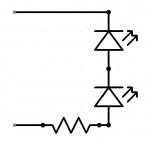"I'm sure Dippy can answer for himself,..."
- yes, I have been known to do that.

Amongst my irony and when I'm not joshing (Splutter!) I try and post to get people thinking rather than serve up on a plate.
One of the things I've been waiting for are comments on component selection.
It never happens.
You , quite rightly, suggested a logic level MOSFET. Yup, far better.
We all tend to use similar components for no better reason than someone has used one before - sometimes it's a perfectly good reason too , so I'm not knocking it.
But, when significant , we also have to look at other component specs.
Again I say 'when/where significant'.
In this circuit a lower rated MOSFET may perform better. Especially at higher frequencies.
Why?
Note: I DO appreciate that cost and availability play a part, but when you want the best you may have to hunt.
PS. In any circuit. esp noisy ones, put a capacitor or two on your PIC power pins to act as decouple/bypass.
And I would be tempted to put a small gate resistor in too for a bit of PIC protection potential.


